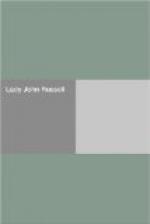MINTO, July 19, 1841
My last day as a child of Minto. How fast it flew. How quickly good-night came—that sad, that dreaded good-night. But sadness may be of such a kind as to give rise to the happiest, the purest feelings—and such was this.... He and I sat in the Moss house. Never saw the glen more beautiful; the birch glittering in the sun and waving its feathery boughs; the burn murmuring more gently than usual; the wood-pigeons answering one another from tree to tree. Had not courage to be much with Mama.
They were married on July 20th in the drawing-room at Minto, and set off for Bowhill, which had been lent them for the honeymoon by the Duke of Buccleuch. Never did statesman on his wedding-day take away a bride more whole-heartedly resolved to be all a wife can be to him in his career. Her mother was now perfectly happy about the marriage, though the disparity of age, and fears about the great responsibility her daughter was undertaking in the care of a young family—one boy and five girls—had undoubtedly made her anxious. Lady Minto felt very deeply the parting with her dearly-loved child, and after the wedding she sent her the following little ballad:
A BORDER BALLAD
AIR: “Saw ye my father”
Oh saw ye the robber
That cam’ o’er the border
To steal bonny Fanny away?
She’s gane awa’ frae me
And the bonny North Countrie
And has left me for ever and for aye.
He cam’ na wi’ horses,
He cam’ na wi’ men,
Like the bauld English knights langsyne;
But he thought that he could fleech
Wi’ his bonny Southron speech
And wile awa’ this lassie o’
mine.
“Gae hame, gae hame
To your ain countrie,
Nor come o’er the March for me.”
But sairly did she rue
When he thought that she spak’ true
And the tear-drop it blinded her e’e.
His heart it was sair
And he lo’ed her mair and mair,
For her spirit was noble and free;
“Oh lassie dear, relent,
Nor let a heart be rent
That lives but for its country and thee.”
And did she say him nay?
Oh no, he won the day,
Could an Elliot a Russell disdain?
And he’s ta’en awa’
his bride
Frae the bonnie Teviot-side,
And has left me sae eerie alane.
Oh where’s now the smile
Used to cheer me ilk morn,
Like a blink o’ the sun’s
ain light;
And where the voice sae sweet
That aye gar’d my bosom beat
When sae saftly she bade me gude-night.
Now lang, lang are the nights
And dowie are the days
That sae cheerie were ance for me.
And oh the thought is sair
That she’ll mine be never mair,
I’m alane in the North Countrie.
MARY MINTO, July, 1841
But before following the future, it will be well to look back. Lord John himself must play so large a part in a biography of his wife that a sketch of his life up to this point, and some reminders of the kind of man he was, may interest the reader; not a review of his political achievements, but an outline of the events which had left him at his second marriage a leader among his countrymen.




